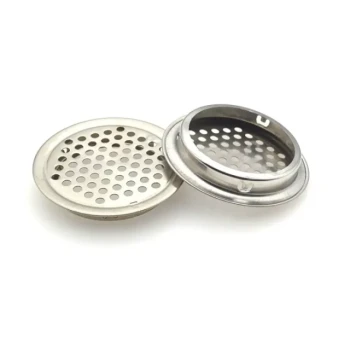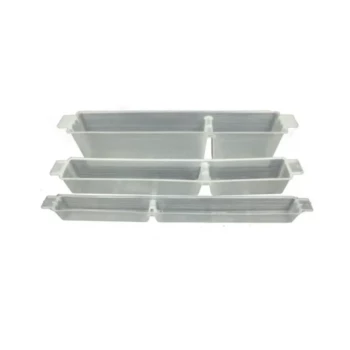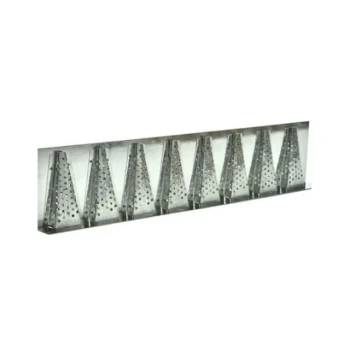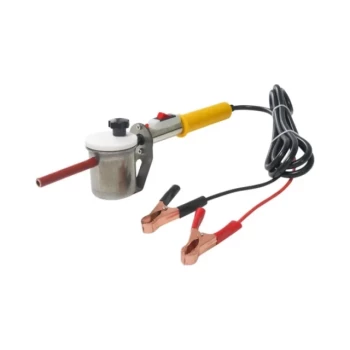At its core, the oval-shaped hole in a beehive's inner cover serves a dual purpose. It functions as an upper entrance and exit for the bees and is specifically shaped to accommodate a device called a bee escape, which is used to clear bees from honey boxes before harvesting.
The inner cover is far more than just a secondary lid; it is a critical tool for managing the hive's internal environment. The central hole is the key feature that enables its most important functions: ventilation, hive access, and simplified honey harvesting.
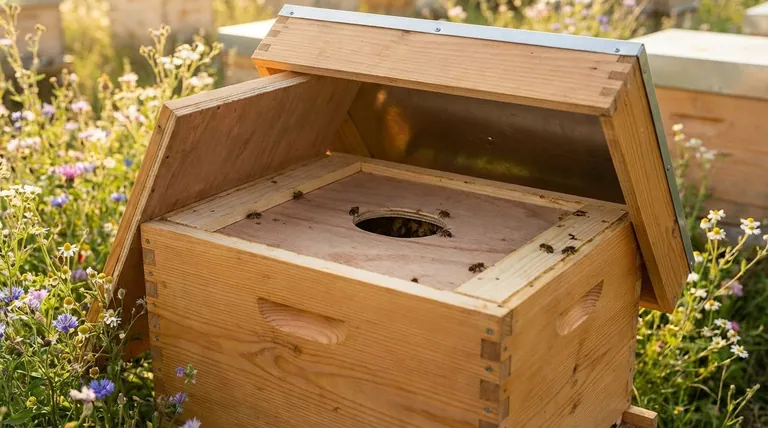
The Inner Cover's Role in Hive Health
Before focusing solely on the hole, it's essential to understand the purpose of the inner cover itself. It sits directly on top of the uppermost hive box, just beneath the main telescoping outer cover.
Creating an Insulating Airspace
The inner cover creates a pocket of dead air between the colony and the outer world. This space provides crucial insulation, helping to shield the bees from extreme summer heat and winter cold.
Maintaining Proper "Bee Space"
Bees instinctively fill any gap larger than 3/8 of an inch with wax comb and seal smaller gaps with a resin called propolis. The inner cover prevents them from gluing the outer cover directly to the frames, which would make hive inspections incredibly difficult.
Simplifying Hive Inspections
By creating this separation, the inner cover allows a beekeeper to remove the outer cover with minimal disturbance. You can then gently pry off the inner cover, giving the bees more warning and resulting in a calmer colony during inspections.
Why the Central Hole is Essential
The hole transforms the inner cover from a simple spacer into a versatile management tool. Its functions adapt to the changing needs of the colony throughout the year.
A Secondary Entrance and Exit
The hole provides an alternate access point for the bees. This is particularly useful in winter if the main bottom entrance becomes blocked by snow or debris, ensuring the bees can still fly on cleansing flights.
Aiding in Hive Ventilation
Proper airflow is critical for a colony's health. The hole allows bees to more effectively circulate air, which helps cool the hive in the summer and, more importantly, allows moisture from their respiration to escape during the winter, preventing condensation from dripping on the cluster.
Accommodating a Bee Escape
This is the reason for its specific oval shape. A bee escape is a small, one-way valve for bees. When preparing to harvest honey, a beekeeper places the inner cover below the honey boxes (supers) with the bee escape installed. The bees can travel down through the escape into the brood boxes but cannot get back up, clearing the honey supers of bees within 24-48 hours.
Understanding the Trade-offs
While essential, the functionality of the inner cover and its hole requires active management based on the season and your goals.
Potential for Heat Loss
While ventilation is crucial, an open top entrance can be a significant source of heat loss during the winter. Many beekeepers place a block of wood or other material over the hole in cold climates to help the colony conserve warmth.
Different Design Philosophies
You will find variations in inner cover design. Some have a notched rim for an upper entrance instead of, or in addition to, the central hole. Others are solid or insulated specifically for overwintering in harsh climates.
How to Use the Inner Cover Effectively
Your management of the inner cover's hole should change with the seasons and your beekeeping objectives.
- If your primary focus is honey harvesting: Use the hole to fit a bee escape below your honey supers for an easy, chemical-free way to clear them of bees.
- If your primary focus is summer ventilation: Ensure the hole is clear and prop the outer cover up slightly to create an air gap that maximizes airflow and helps the bees cool the hive.
- If your primary focus is winter survival: Consider blocking the hole to conserve heat, especially in colder climates, while ensuring the bees have a clear lower entrance.
Ultimately, mastering the use of the inner cover is a key step in becoming a responsive and successful beekeeper.
Summary Table:
| Function | Purpose | Key Takeaway |
|---|---|---|
| Ventilation | Allows moisture to escape, preventing condensation in winter and aiding cooling in summer. | Critical for hive health and winter survival. |
| Secondary Entrance | Provides an alternate exit if the main entrance is blocked, crucial for winter cleansing flights. | Ensures bee access and hive safety. |
| Bee Escape Accommodation | The oval shape fits a one-way valve device to clear bees from honey supers before harvest. | Enables easy, chemical-free honey harvesting. |
Ready to optimize your hive management? The right equipment is key to a healthy, productive colony. HONESTBEE supplies durable, precision-crafted beekeeping supplies and equipment to commercial apiaries and beekeeping equipment distributors through wholesale-focused operations. Let us help you build a more efficient and successful operation. Contact HONESTBEE today for wholesale pricing and expert support!
Visual Guide

Related Products
- Inner Beehive Cover for Beekeeping Bee Hive Inner Cover
- Professional Insulated Winter Hive Wrap for Beekeeping
- Stainless Steel Round Beehive Air Vents for Ventilation
- Professional Hive Top Bee Feeder for Beekeeping
- In-Hive Dual Compartment Frame Bee Feeder for Targeted Colony Nutrition
People Also Ask
- What is the role of the inner cover in a beehive? Essential Climate Control for Hive Health
- What is the role of inner covers in insulated beehives? Master Moisture Control for a Healthy Colony
- How is the inner cover used to promote ventilation? Master Hive Climate Control for Healthy Bees
- What is the function of an inner cover in a beehive? Essential for Hive Health & Management
- What is the purpose of the inner cover in a beehive? A Key to Hive Health & Easy Management


